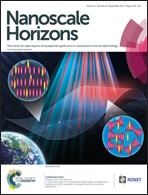Metal–organic framework derived hollow CoS2 nanotube arrays: an efficient bifunctional electrocatalyst for overall water splitting†
Abstract
Self-supported hollow nanoarrays with hierarchical pores and rich reaction sites are promising for advanced electrocatalysis. Herein, we report a rational design of novel CoS2 nanotube arrays assembled on a flexible support which can be directly utilized as an efficient bifunctional electrocatalyst for overall water splitting. Uniform wire-like metal–organic framework (MOF) nanoarrays were first fabricated and a sulfidation process by thermal treatment was carried out to transform the MOF arrays into CoS2 nanotube arrays. The unique hollow CoS2 tubular arrays are shown to provide high surface area for an efficient electrochemical reaction, and the well-defined electrical/mechanical connection to the substrate enhances both mass and electron transfer. The CoS2 nanotube arrays exhibited a high electrochemical activity in catalyzing both oxygen and hydrogen evolution reactions, in terms of low onset potential, high current density and excellent stability. Using the CoS2 nanotube arrays as catalysts, a water-splitting current density of 10 mA cm−2 in alkaline solution is achieved with a cell voltage of 1.67 V, and the stable current can be maintained for 20 h even when the electrode is in a bent state.

- This article is part of the themed collection: Nanoscale Horizons 10th anniversary regional spotlight collection: Asia-Pacific


 Please wait while we load your content...
Please wait while we load your content...